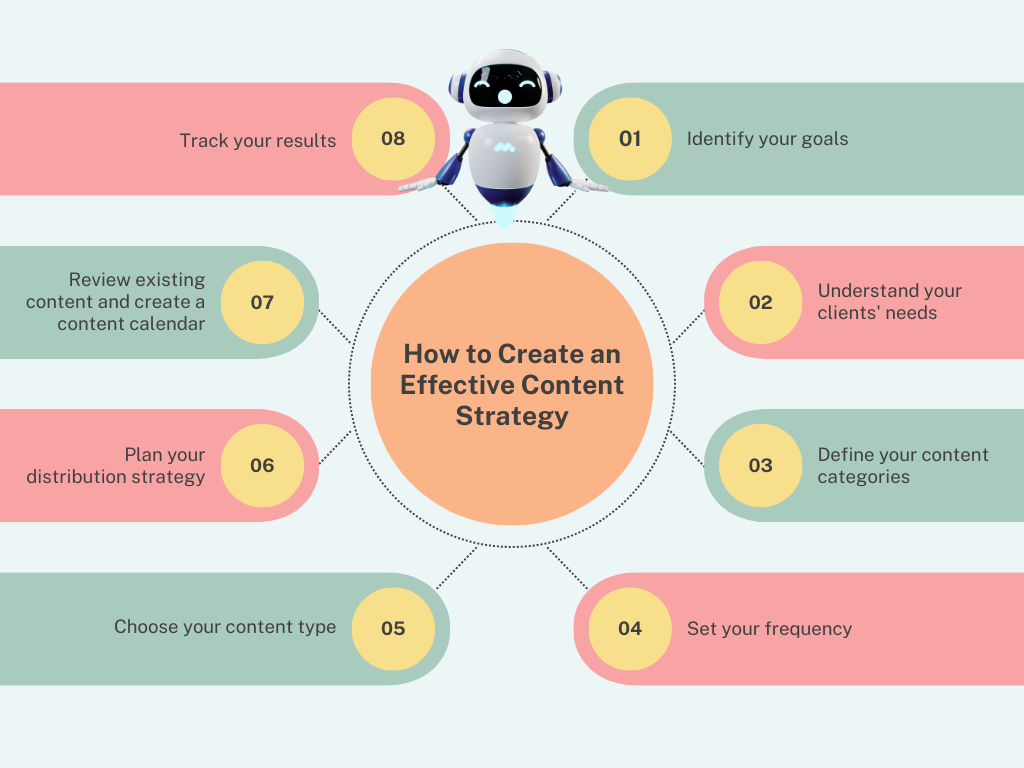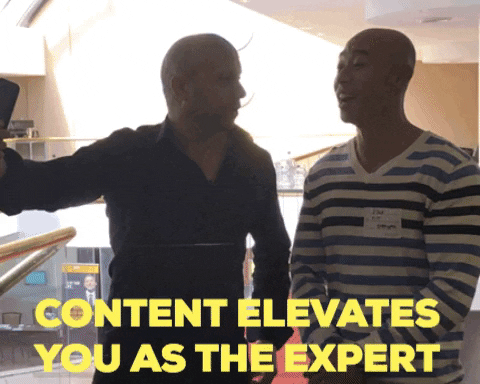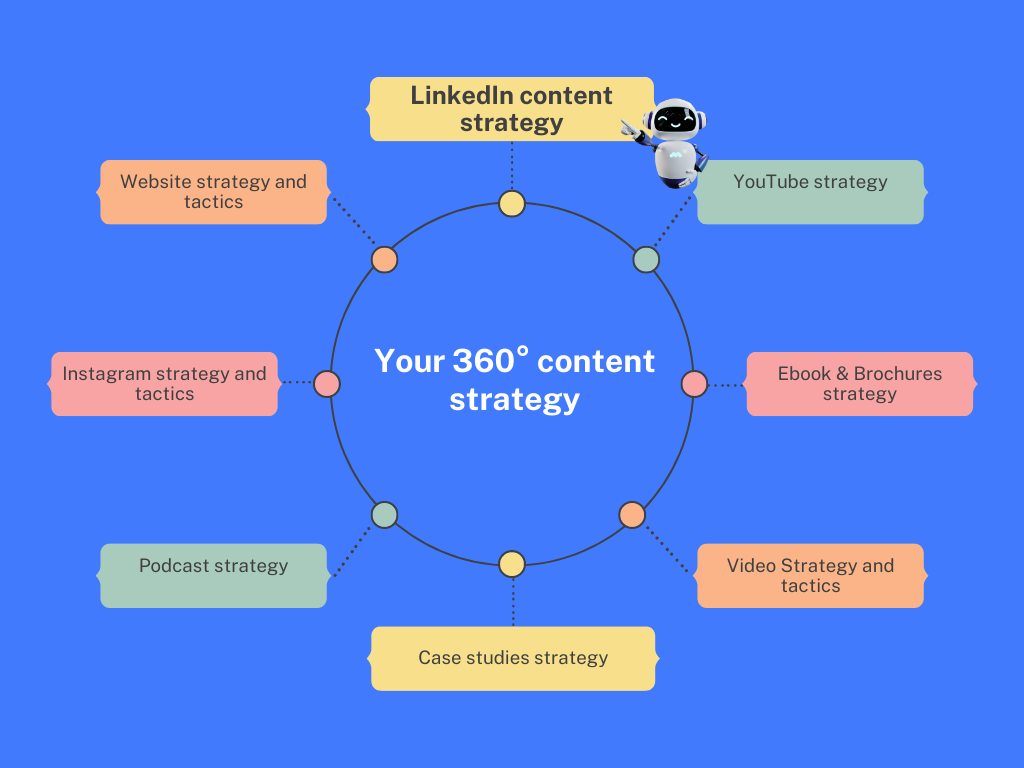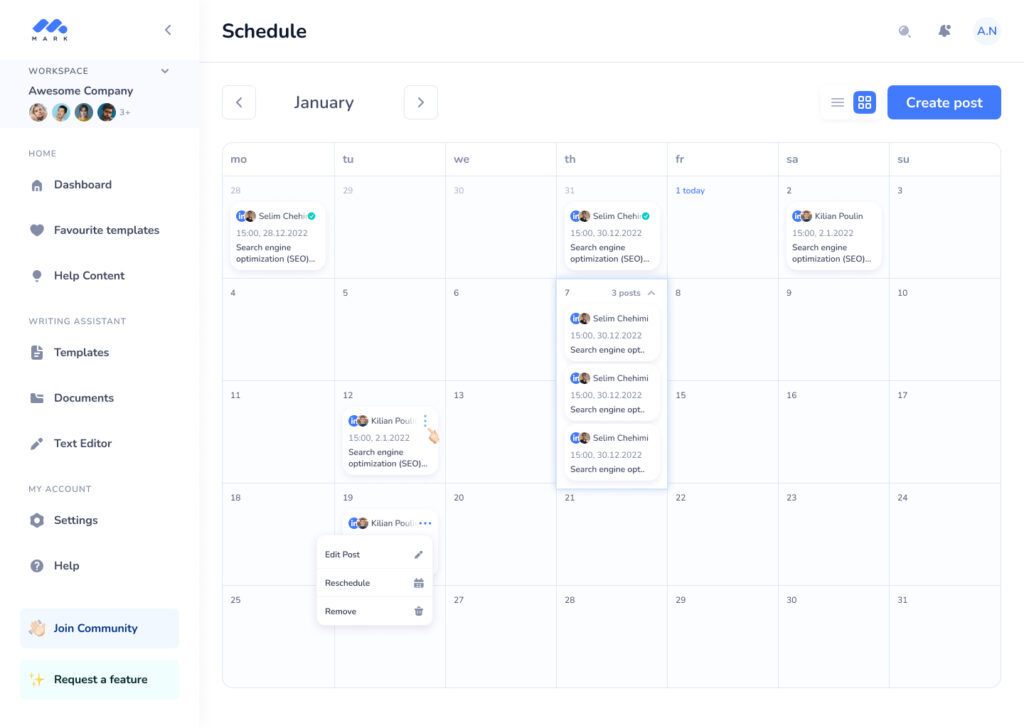LinkedIn is a great platform for B2B marketers and for your personal brand – you can easily chat with potential customers and get the word out about your brand. 📣
If you’re new to the platform though, it can be a bit confusing. Or you might struggle to scale your audience. Don’t worry – this guide will help you get started, build your personal brand, and get your LinkedIn posts seen by more people.
Let’s do this! 🚀
Video Walkthrough
What is Content Strategy?
Have you ever heard the term “content strategy” used by marketers? 🧐
If you’re not sure what it means, don’t worry – we’ve got you covered!
This article gives you a brief overview of what content strategy is, how it’s used, and how it can improve your marketing efforts on LinkedIn.
First of all, let’s figure out what a content strategy actually is.

Developing a content strategy is a great way to make sure your content is on-brand and follows your company’s voice. It’s basically a roadmap for your content – it lays out the guidelines for how it should be created, organised, and distributed.
Sounds like a plan, right? 🙂
So basically, a content strategy focuses on the planning, creation, delivery, and governance of content.
It’s used to meet business objectives by targeting the right messages to the right people, at the right time and in the right channel.

A content strategy involves:
👉 Identifying your goals
👉 Getting everyone in your organization on the same page about how and why you should publish content.
👉 Defining and organising content around what audiences need and expect from your business, rather than around popular topics or keywords.
👉 Prioritizing the content that matters most to your business so it’s easier and faster for you to publish.
For example, you might start with what we call “bottom of funnel content”. These type of content are more suited for conversions and should be prioritised.
👉 Improving the frequency and quality of your content.
👉 Setting up systems for tracking and measuring how people interact with your content.
To implement a content strategy, you need to identify what information is important, how to organize it, and how to publish it in multiple channels (such as LinkedIn – our focus in this blog post, email newsletters, blogs, and other social media).
What Is The Purpose Of A Content Strategy?
A content strategy is like a roadmap for your content – it’s about how, when, and what you publish.
It’s the thing that keeps everything together and helps your users find the information they need quickly and easily.
Content strategy doesn’t have to be hard, but it does require time and effort.
Having a set of guidelines to follow can make it easier to get started.
A great content strategy can help you:
💡 Organise your content.
💡 Generate leads.
💡 Convert leads into customers.
💡 Create an experience for your customers that makes them want to return to you over and over again.
💡 Build trust.

How Do I Create A Great Content Strategy?
A great content strategy comes from a great understanding of your audience and what they need from you. If you’ve done the work of creating buyer personas, then you’re halfway there.
Now it’s time to dig deeper into what they really need, what they really want, and how they really think.
What Is A Content Strategy For LinkedIn?
Before to post on LinkedIn, you need to define the goals that you want to achieve on the platform – why are you posting there ?
How often will you post ? Will your team post with you ? Which results do you expect ? Answer all of these questions in your LinkedIn content strategy.
Your LinkedIn content strategy should be included in your overall content strategy. It’s a piece of the puzzle 🙂

Why you need a content strategy before posting on LinkedIn
If you’re not using a content strategy to plan out your LinkedIn posts, you’re missing out on an awesome opportunity to get your business in front of your ideal customers. 🚨
A LinkedIn content strategy will help you decide what to post and how often, what types of content perform best, and which types of posts will help you reach your sales goals.
It will help you get consistent over time as well. 📈

With a content strategy in place, you’ll easily be able to tell which pieces of content are working and which aren’t, so you can adjust your strategy as needed.
I like to call this “the content feedback loop” – it’s your opportunity to check in and see how your content strategy is working for you. 🔁
Having this content strategy in place will also help you to figure out what happens outside of LinkedIn. Always keep in mind that you need a overall content strategy. The LinkedIn content strategy is just a part of that bigger plan.
Then, you can ask yourself questions like how do I drive people from LinkedIn to my email newsletter…
But don’t worry if you’re not sure where to start – we’ve got your back! We’ve put together a comprehensive LinkedIn content strategy guide to help you plan your next LinkedIn post, so you’ll be crushing your goals in no time. Check it out here!
7 Steps To Create A LinkedIn Strategy For Businesses (B2B) From The Ground Up (With Examples)
LinkedIn is growing its audience at a rapid pace, which gives content marketers an incredible opportunity to reach existing and potential customers. LinkedIn currently has more than 500 million members, and new users are joining every week. LinkedIn pushes out more than 10 posts a second to its users, which amounts to more than 1.5 billion posts a month. LinkedIn also boasts over 300 million monthly active users on its mobile app.
Linkedin is one of the most powerful b2b social networks and it can be used to create a professional network, promote products and services, post valuable content and generate traffic.
LinkedIn is a great place to make connections and share information with millions of other professionals. 🙌
Plus, it’s an awesome platform for businesses and individuals to market themselves, their products, and services.
Let’s focus on building your B2B LinkedIn content strategy from the ground up. 😎
Step 1: Define your target audience
Know your target audience first.
Think about their age, gender, location, profession, interests, and the type of tone you want to use when writing your LinkedIn posts.
The more you know about them, the better you can tailor your content so it speaks to them.
Go talk to them and ask them what kind of content would be useful (cf. step 3)

When defining your target audience, what helps is to have a document like this. It can include :
- A general description of your target audience 👩💻👨💻
- The goals they want to achieve 🎯
- Their main problems (knowing them will help you to create the right content) 😩
- The type of content they generally consume (don’t hesitate to include the different preferred channels) 👀
- The content to create (use main problems and make a list answering the pain of your target audience) ✍️
Step 2: Decide on the goals you want to achieve
It’s important to think about why you’re doing all this and what you want to get out of it.
Taking the time to set your goals now will make it easier to move onto the next step.
Make sure to take your time and plan it out – it’s worth it!
Here are some goals ideas to get inspired from:
- Increase number of qualified leads 📈
- Increase your reach and brand awareness 📣
- Develop your personal brand 😎
- Promote your brand for recruiting 🤝
Each of these goals requires different kind of LinkedIn posts. That’s why building a LinkedIn content strategy is 🔑
As a general rule of thumb, I recommend to keep promotional content lower than top of funnel content.
For example you can have 65% of your content answering general questions of your audience.
And 35% of your content or less providing solutions with your product / service.
Step 3: Define and prioritise your content
You’ve got to be strategic here – don’t just post anything. ❌
Make sure what you post is actually valuable to your prospects and something they’ll actually want to read.
If you’re not sure, why not ask your customers what they want to see? 😉
That way, you’ll know what kind of content they prefer and what types of content you should use. If you don’t know where to start, just go with the basics.
You can always add more types of content later, but it’s important to have a good foundation first.
With the right tools and techniques, you can create an awesome social media marketing strategy that’ll help your biz grow! 🛠
It’s a great way to spread the word about your products and services, and to keep your customers in the loop about the latest news and promos. Here’s what you should do:
– Choose the social media platforms your business should use
– Create a content calendar (see step 5)
– Decide on a target audience and their characteristics
– Decide on the type of content you want to post
– Plan your posts and schedule them accordingly (step 6)
Step 5: Define your LinkedIn content strategy
Now that we have your full content strategy, we can focus specifically on the LinkedIn one. This is where you decide the type of content you’d like to post to your LinkedIn profile, the frequency of posting, and the best time to post them.
The more quality content you post, the more engagement you’ll get, which will lead to more potential clients!
Here are some of the factors you should consider when defining your LinkedIn content strategy:
👉 How often should I publish content?
👉 What type of content should I use?
👉 What’s the best time of the day to publish?
👉 What types of content perform best on LinkedIn?
👉 What do my competitors do?
👉 How can I improve my content?
👉 Who is my ideal client?
👉 What time of the day do my target audience spend the most time on LinkedIn?
👉 What are their interests?
👉 What are their pain points?
👉 What are they doing on LinkedIn?
👉 What makes them tick?
👉 What type of content do they need/want?
👉 How do I get them to like, comment and share my posts?
👉 How can I build a relationship with them?
👉 How can I make them trust me?
👉 How do I get them to other platforms I own (emails, blog posts…)
Step 6: Have a content calendar for your LinkedIn posts
This is a crucial step to building a rock-solid LinkedIn strategy for your business.
To really make the most of it, you’ll need a content calendar.
Content calendars are great for staying consistent, building your brand, and maximizing your overall strategy. They help you plan and schedule your posts so that you can stay on top of things.
Plus, they let you prioritize the content you share according to your goals. Pretty cool, right? 😎
We highly recommend using Mark Copy AI to create your LinkedIn posts and schedule them using Mark Copy’s content calendar. You’ll have one place to organise all of your content creation:

Step 7: Create content with your entire team
When it comes to creating content, it makes sense to get the whole team involved! You might be the one doing the writing and posting on social media, but it’s important that your employees are part of the process too.
That way, you can make sure that everyone is working together towards the same goals and that your content is consistent.

Let’s go through a last small bonus to show you what to include in your B2B LinkedIn Content strategy. These tips should help you build trust and credibility with your target audience.
Don’t forget your industry’s news
Staying on top of your industry’s news, events, and other relevant topics is key.
By sharing industry’s news you’re always top of mind in your industry and people trust you more!
And trust leads to business. 💸
Always write content that matters to your audience
If you want to make your content strategy a success, it’s all about writing content that your audience cares about. Don’t waste your time writing about stuff that doesn’t matter – always keep your audience in mind.
That’s the key to content success! 🔑
Now, let’s focus on more specific content strategy on LinkedIn: one for your personal brand.
LinkedIn Content Strategy for Personal Branding
This is a simple to follow presentation on how to successfully use content to develop your personal brands on LinkedIn. After watching you’ll understand what content you need to create and how to distribute it for maximum impact.
Here are 6 steps to create a content strategy to develop your personal branding:
1. Defining success
Defining the success of your personal brand is important because it will help you figure out what you need to do in order to achieve it. You have to determine what you want your personal brand to become, and what kind of content will help you achieve it.
2. Defining your audience
Defining your audience is important because it will help you figure out who you need to reach out to in order to become successful. You have to determine who your target audience is, and what kind of content will attract this audience.
3. Defining your personal brand
Defining your brand voice is important because it will help you figure out what kind of tone you should take when creating content. You have to determine what you want your brand voice to be, and what kind of tone will match the image you want to create.
4. Defining your content
Defining your content is necessary because it will help you figure out what kinds of content you should create in order to create a successful personal brand.
The first step in deciding what kind of content you want to create for your LinkedIn audience is to decide what kind of format your posts will take. This is important because it will help you determine how frequently you need to create new content, and what kinds of content you should create for this type of format.
For example, you might be better at videos, then do video posts on LinkedIn!
Also don’t hesitate to experiment with different kind of content format and see which one you prefer.
5. Creating your content
Now that you know what kind of content you should create, it’s time to create your content! The next step is to create your content.
The best way to create your content is to use a very simple process:
1. Create an outline for your new post
2. Write your post
3. Polish your content
Creating an outline for your post
Creating an outline for your new post will help you get the most out of your writing time, and make sure that you don’t forget any key points. An outline will also help you stay focused on the topic of your post.
1. Come up with a topic: The first thing you need to do is come up with a topic for your post. This can be as simple as asking yourself a question, or thinking about an idea that has beenon your mind. For example, “how do I get more traffic to my blog posts”.
Come up with an outline: Once you have a topic, you can start writing an outline for your post. This can be as simple as listing out bullet points that match the topic of your post. For example:
Write your post
Now that you have a topic and you’ve created an outline, it’s time to write your post! Start by following your outline, and write out each point on your list. Then, when you’re done, go back through each of your points and make sure that they are all relevant to the main topic of your post. The final step is to proofread your post before publishing it.
Polishing your content
The best way to polish your content is to leave it alone for a while, andthen come back to it after you’ve had some time to let it marinate. Examine the grammar, the syntax, and try to simplify your post
Using MarkCopy AI 🤖
AI can help you to get LinkedIn post ideas in seconds!
To get started, simply type a topic that you’d like to write about in our LinkedIn post generator.
Now you’re ready to write content faster!
6. Distributing your content
Now that you’ve created your beautiful piece of content, the last thing you want to do is let it sit on your computer. You need to distribute it out to the world, so that other people are able to see and read it!
Putting it on your LinkedIn profile
The first place that you’re probably going to want to put your LinkedIn post is right on your profile! Go ahead and click on your profile picture in the top-left of the screen, and you’ll see a little drop-down menu that includes an option for posting. This will let you add a new post to your profile.
Linking to it from all of your other social media accounts
After you’ve put up your post on LinkedIn, it’s time to take that content and spread it out across all of your other social media accounts.
LinkedIn content: 4 tips for success
1. Use Visuals.
Posting links to articles and blog posts is one of the most common ways to get your content in front of an audience on LinkedIn. The problem is, there are limitations to how much text you can include in one link post. The best way to overcome this limitation is to create images using infographics or stock photos, then post the image along with an enticing headline. Studies show that posts with images attract more interest than those without images. “The average image shared on Linkedin gets more than 10 times more engagement (likes and comments) than the average post,” says LinkedIn in a blog post.
2. Post Often.
The more often you post, the more opportunities you have to get your content in front of LinkedIn members whoare actively looking for that content. “Posting once a day is the sweet spot,” says the LinkedIn blog.
3. Post at the Right Times
LinkedIn has found that its members are most engaged in the morning hours, on the weekends and during holidays. Though it can be difficult to post at these times, it’s worth the effort. Posts published on weekends get nearly twice as much engagement as posts published during the workweek. And LinkedIn users are 40% more likely to engage with a post at 8 a.m. or 9 a.m., than they are to engage with a post at 11 a.m. or noon.
Remember to use hashtags in your posts, too! Using hashtags will help your posts be discovered by other users who are interested in the same topics you are. Make sure you use relevanthashtags to your posts and include them in the first comment, rather than the last.
4. Be Relevant
Don’t just post anything. Post relevant content that is interesting to your audience and also valuable for it. Make sure you’re posting content that would be of interest to your target audience, as well as content that would be helpful to them. For example, if you’re a career coach, you may post on LinkedIn about how to find a job, how to write a resume, how to get hired, etc. If you post content that would be of interest to people who are looking for jobs and would help them in their career search, then you will get better engagement with your posts.
To get your posts to be seen by the right people, you should also consider making it part of your post to ask for likes and comments, as well as including a call-to-action in the first comment.
100 LinkedIn Post Ideas And Examples To Swipe For Your Business
Looking to get your name out there? This is the place to be! Here are 50 awesome post ideas and content examples to help you get started. Let’s get creative!
The Ultimate List of 100 LinkedIn Post Ideas
Are you struggling to come up with ideas for your LinkedIn posts? Look no further! We’ve compiled a list of 100 post ideas that will help you increase engagement and grow your visibility on LinkedIn
Conclusion
Hey, the social media game is always changing, so it’s important to stay on top of it if you want to succeed. We’re sure that if you create a content strategy for LinkedIn, you’ll reach your goals and beyond.
Just stay consistent and don’t give up and you’ll be golden. Good luck! 🚀🔥

CEO @MarkCopy

0 comments